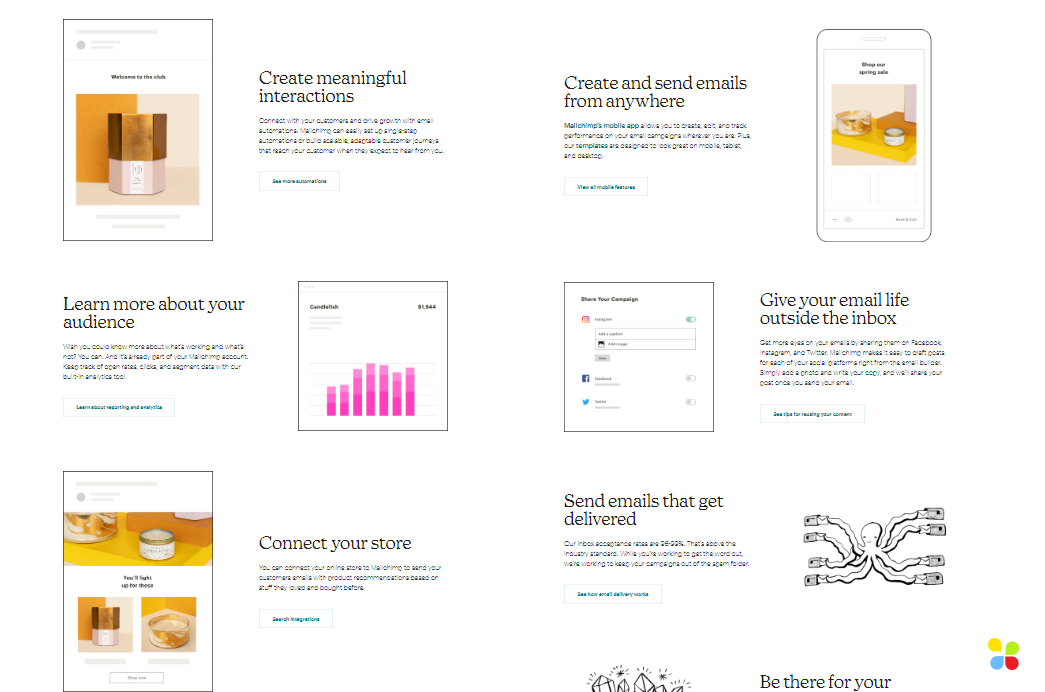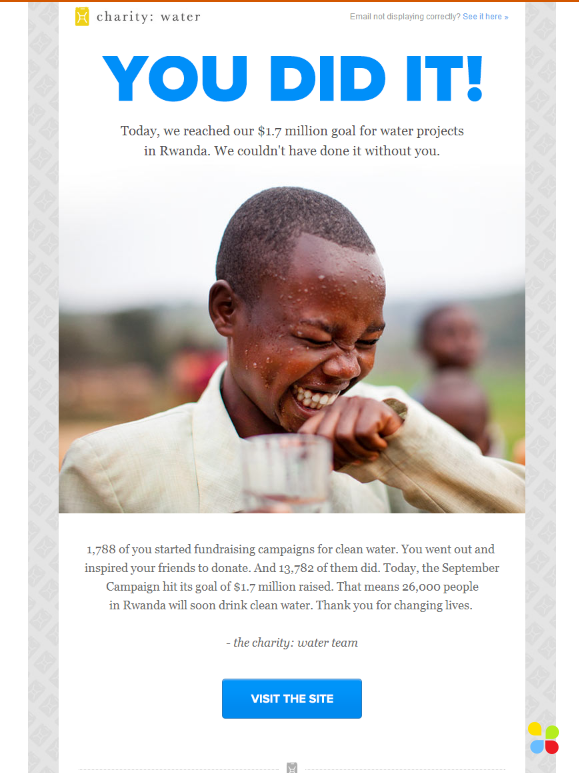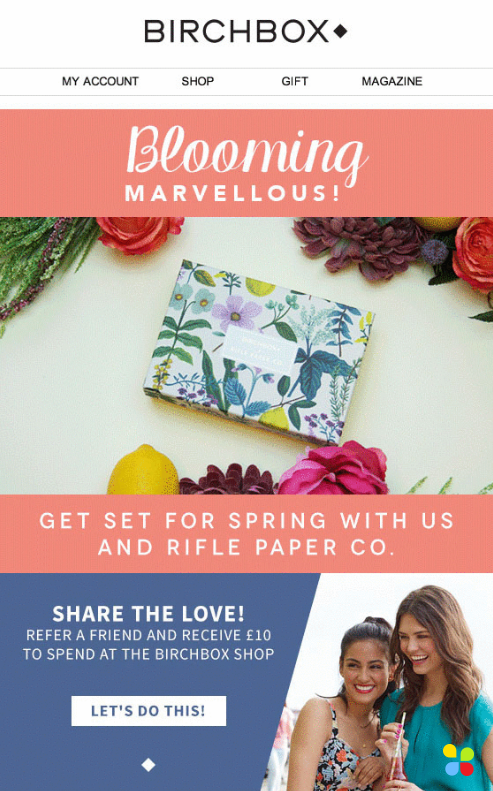
With about 320 billion emails sent every day, as a business owner you have your work cut out in wresting away your audience’s attention away from the competition. It’s apt then to wonder how to create an email campaign that converts.
Let us walk you through the necessary steps it takes to get your potential customer’s attention and keep it!
Contents
- What is an Email Marketing Campaign?
- Determining Your Goals
- Understanding the Types of Email
- Finding the Right Audience
- Segmenting Your Market
- Using the Right Email Marketing Services
- Creating Your Subject Line
- Crafting the Email Copy
- Placing A Clear Call-to-Action
- Track and Analyze
- Email Sending Frequency
- Are You Ready to Start Emailing Yet?
Understanding an Email Marketing Campaign?
An email marketing campaign involves sending different type of content via email to people who have subscribed to your website. If the content is done right, it can encourage your prospects to take certain action that can result in an increase in website traffic, leads, and even sign ups that lead to higher sales.
One of the biggest benefits of running an email marketing campaign is that you can revive dead leads through effective emails. This makes email marketing an ideal tool for garnering business and re-discovering prospects you might have lost before.
But before you start sending your email left and right, you need to do some prep work.
Determining Your Goals
To run a successful email marketing campaign, you need to set concrete and realistic goals about what you want your campaign to achieve. Your email marketing campaign should include:
- Welcoming new subscribers, making them aware of your business and brand values and building a relationship with them.
- Driving engagement with your content and brand
- Nurturing your existing subscribers by offering them valuable content
- Sending reminders to existing subscribers who have not been actively engaged
- Retaining subscribers and turning them to brand ambassadors
Your email marketing goals can also be set based on your conversion goals.
Understanding the Types of Email
There are dozens of different types of emails that you can send. Typically, though, emails may be categorized into three broad groups:
Promotional Emails
We are all familiar with emails that talk about buying a particular product or discount and/or offering discounts.
Relational Emails
These emails provide people who have previously subscribed with something of value like relevant information or a free gift. One of the most common types of relational email is a newsletter.

Screenshot: Buzzfeed Tasty
Transactional Emails
These emails are in response to certain actions a subscriber has taken on your site. Some common types of transactional emails are sign up confirmation emails, welcome and thank you messages, order confirmation messages, and subscriber information change acknowledgements.
Finding the Right Audience
If you have been in business for a while, you probably know who your audience is. However, if this is your first time developing an online marketing strategy, you will need to do some research and make educated guesses to find the right audience for your content.
If you want to gather reliable data, you can do so by perusing Google Analytics data or social media insights like Facebook Insights for your social media profiles. Most analytics tools offer you comprehensive data on demographics, customer interest, location, and other statistics that can give you snapshot of your audience.
If you want to know how to create an email campaign and where to begin, analytics is a good place to start.
Segmenting Your Market
Before you dive into creating an email campaign, study the profiles of your potential customers. They may have enough information that can help you segment your market. For example, if you are running a lawn maintenance company, your main targets need to have a lawn in their homes.
The next important segmentation is the location, since a lawn maintenance company will operate within a certain radius. Hence, visitors to your website who have come from far-flung areas may need to be ruled out. Age is also a factor since typically people over the age of 25 earn enough to own a house.
There are some additional factors you need to consider as well. For example, if you want your lawn maintenance company to only cater to high-end customers, you will need to segment those customers from your market as well. For that, you will need to determine your customers’ career, income level, and educational level.
By segmenting your market, you not just find out who your ideal customer is, but it also helps you in determining your marketing strategy. In case of rich clients, hardselling tactics or emphasizing how affordable your lawn maintenance services are may not be the best strategy. Instead, you need to focus on quick and convenient services that provide additional value beyond the ordinary.
In addition, profiling your customers also help you in deciding what kind of copy, images and graphic design you should use in your email campaign.
Studies show that segmenting your market can improve your email click-through-rate by 50%.
Using the Right Email Marketing Services

Screenshot: Mail Chimp
There are plenty of email marketing tools available in the market. If you want to know how to create effective email campaigns, you will need to use the best tools in the market which include features and options like:
- Templates and workflows
- Offer easy creation and automation of email campaign
- Can offer you ways to segment your audience
- Readily integrate with software you use
- Provide in-depth metric and analysis of the performance of your email campaign.
- Help you respond quickly to your target customers.
Some of the popular types of email builders and marketing tools are MailChimp, Constant Contact, OptinMonster, and Hub Spot.
With an email builder that contains comprehensive tools, you can create, personalize and optimize your email campaigns in an easy and convenient way possible.
Creating Your Subject Line
Once all the market research has been done, now it is time for you to start working on the copy and design of your email.
Of course, if you want your email marketing campaign to be successful, you need to create a subject line that packs a punch and that prompts people to open and click on your email. Just like a header of a blog post, an email subject line needs to hook the audience and reel them in.
The tricky part is that you do not have a lot of space to make a big impression. Most subject lines range from 40 to 50 characters so you need to maximize on them. Also keep in mind that in mobile view, your even less of your subject line will show, so it would be smart to place the most important bits of the subject line at the beginning.
A few smart ways you can prompt your customers to click on your subject line include:
- Adding a person’s name in the subject line to grab their attention and keep them engaged.
- Informing them of getting something of value when they click on the email.
- Avoiding spam trigger words that can have your email landing in the junk folder.
Crafting the Email Copy
Just like your subject line, your email copy should have a hook right at the beginning that will coerce your audience to keep on reading.
The best email marketing copies are short and do not pitch the offer very early on in the copy. It is important to add the element of personalization into your email copy to keep your audience interested. The simplest way to do that is to address the subscriber by their name, not a generic “Sir/ Madam.”
Other ways to craft a successful email copy include:
- A personal story, which forges an emotional connection between the customer and the brand and makes the customer feel vested in the success of an organization. Take a look at this beautifully-designed email newsletter by charity:water:

- Something of value. This can be a piece of information or resources that can make it clear how the reader will benefit by clicking on the email.
- A video, infographic, poll, or survey, which are considered excellent tools for keeping the readers engaged.
Not every one of these strategies needs to be put into a single email. The best emails are short with less than five main points in the copy. If you want to send longer emails, make sure they offer bite-sized information and are easily scannable.
Placing a Clear Call-to-Action

Screenshot: BirchBox
Last but not the least is the call-to-action (CTA). This is the most important part of the email from the business perspective since it reflects the sole reason the email was sent. That means they need to be highly visible.
Depending on the length of your copy, a CTA can appear once or multiple times in your email. In longer copies, even though you do not want to pitch the reader too soon, CTAs can be found near the top, in the middle, and finally at the bottom. However, again, this depends on the design of your email.
The best calls-to-action are prominent, short, and clear. If you have designed your email right, then your reader will be led naturally to the CTA link.
Track and Analyze
Sending out your email is just the first step of your email marketing campaign. The most important part is the performance and results of your email and to collect relevant data that can help you improve future email campaigns.
Your analytic services can help you track and analyze your specific actions, find out the number of clicks and conversions, and help you make informed decisions based on these.
That means performing A/B testing on everything including the subject line, marketing copy and the CTAs. When performing your tests, some of the most important metrics you need to measure is the open rate, click rates, conversions, and unsubscribes. This will help you find out which efforts are working, which need improvement, and which should not be repeated.
Another important thing you need to watch out for is your email deliverability. You can use tools like Sender Score to check if your emails have any red flags that will prevent it from going into your subscriber’s inbox.
Lastly, you need to manage your email subscriber lists. If you have inactive subscribers, you should come up with an email campaign to re-engage them. If the attempts fail, you should consider removing them from your list. It is better to have a fewer number of active subscribers than a large number of inactive ones when it comes to your email marketing list.
Email Sending Frequency
There is no clear-cut answer to how often you should send your emails. Rather, consider it a balancing act; you do not want to send so few emails that your subscriber forgets about you. On the other hand, you also do not want to bombard them with a flood of emails that will prompt your readers to block you. You need to be assertive but should stop at being annoying.
When it comes to promotional emails, it is better to undersell rather than oversell. In some cases, an infrequent email may seem more valuable to your reader. On the other hand, too many emails is one of the major reasons why many people unsubscribe from a mailing list.
It takes a lot of effort to create an email list so the last thing you need is to lose your prospects because you are too pushy.
So how many emails a week or month should you send? The answer to this can be gotten from A/B testing. Use email segmentation and start sending emails at a slow rate. You may find out that an increase in mail frequency may prompt one group to convert, but it may get the other group to unsubscribe.
On average though, about 40% marketers say they send two to three emails a month. According to Campaign Monitor, the ideal frequency is an email campaign every two weeks.
Having said that, you should always test what works best for you.
Are You Ready to Start Emailing Yet?
We hope by now you have a fairly good idea about how to create an email campaign. We’re sure if you follow our tips, you can level up your email marketing game.
That said; creating an email marketing campaign is not every one’s cup of tea. It takes a whole lot of market research, analysis, testing, time, and resources to set up an effective email campaign.
That means your business will require a dedicated email marketing team to spearhead their email campaign. Conversely, you can make a smart investment by outsourcing to a professional email writing team with years of experience doing the job right.
